Corporate Financial Reports: FNS50215 Diploma of Accounting
VerifiedAdded on 2022/10/14
|10
|2153
|6
Homework Assignment
AI Summary
This document is a comprehensive solution to a corporate financial reports assignment, covering various aspects of accounting and financial reporting. The assignment begins by explaining the double-entry bookkeeping system, its principles, and its importance in detecting errors. It then delves into the significance of ethical principles in the financial service industry and the role of ethical codes. The assignment further explores different types of financial reports, including income statements, balance sheets, statements of cash flows, and statements of change in equity, emphasizing the information they provide to stakeholders. It also discusses general ledgers, BAS/IAS forms, and the frequency of financial reporting. Furthermore, it examines penalties for tax obligations, the differences between cash and accrual accounting, and the importance of budgets and cash flow management. Finally, the assignment concludes by comparing computerized and manual accounting systems.
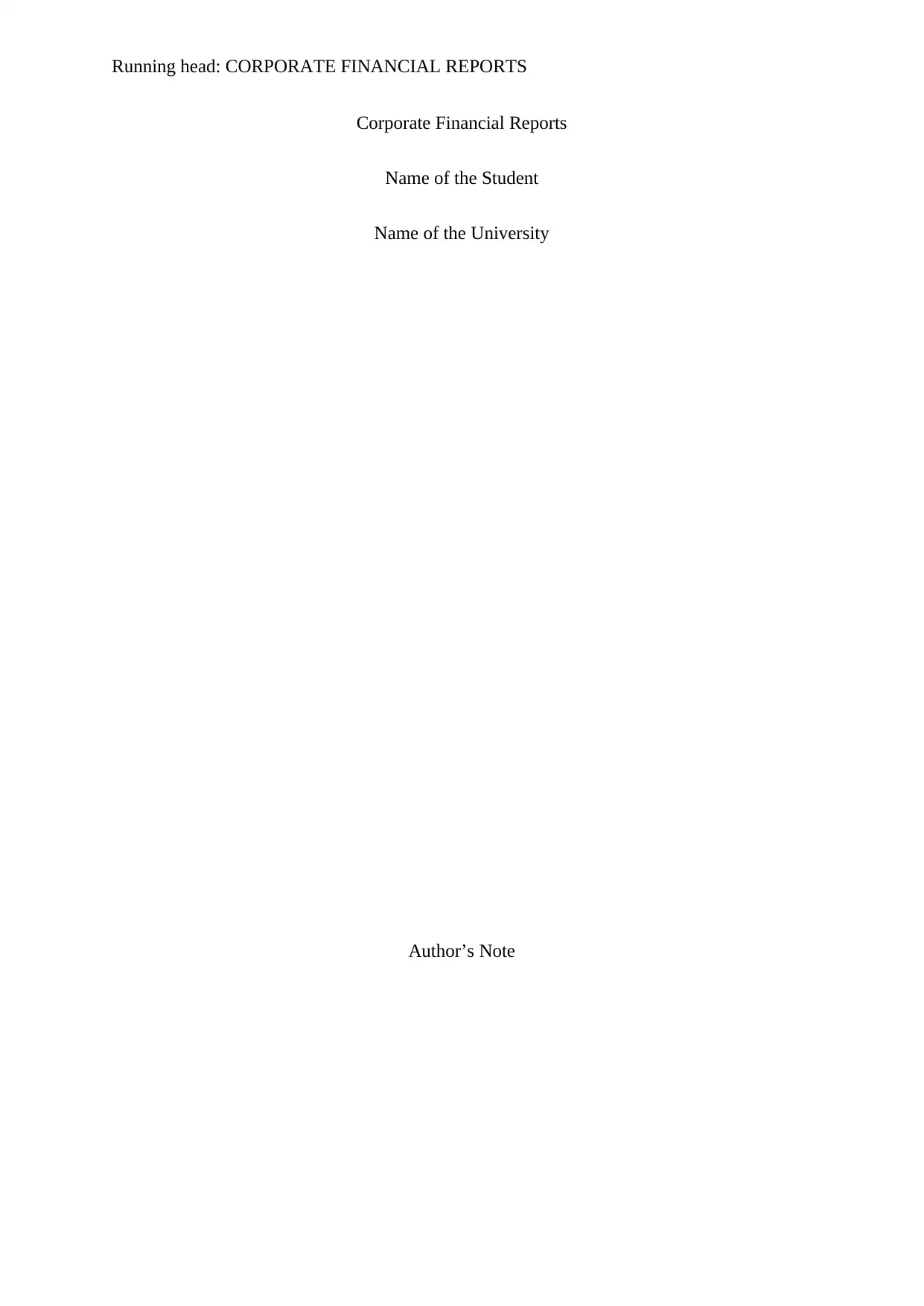
Running head: CORPORATE FINANCIAL REPORTS
Corporate Financial Reports
Name of the Student
Name of the University
Author’s Note
Corporate Financial Reports
Name of the Student
Name of the University
Author’s Note
Paraphrase This Document
Need a fresh take? Get an instant paraphrase of this document with our AI Paraphraser
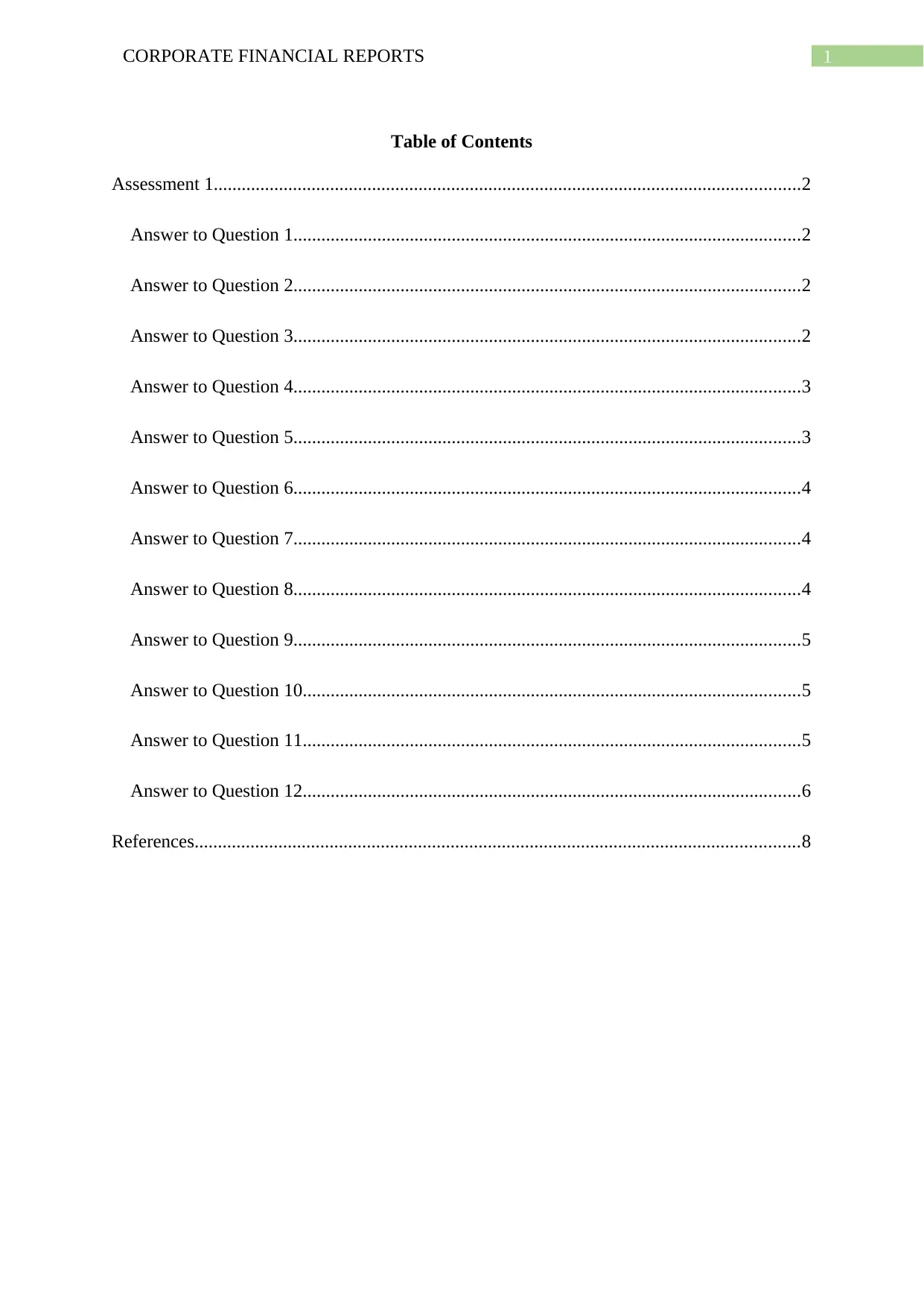
1CORPORATE FINANCIAL REPORTS
Table of Contents
Assessment 1..............................................................................................................................2
Answer to Question 1.............................................................................................................2
Answer to Question 2.............................................................................................................2
Answer to Question 3.............................................................................................................2
Answer to Question 4.............................................................................................................3
Answer to Question 5.............................................................................................................3
Answer to Question 6.............................................................................................................4
Answer to Question 7.............................................................................................................4
Answer to Question 8.............................................................................................................4
Answer to Question 9.............................................................................................................5
Answer to Question 10...........................................................................................................5
Answer to Question 11...........................................................................................................5
Answer to Question 12...........................................................................................................6
References..................................................................................................................................8
Table of Contents
Assessment 1..............................................................................................................................2
Answer to Question 1.............................................................................................................2
Answer to Question 2.............................................................................................................2
Answer to Question 3.............................................................................................................2
Answer to Question 4.............................................................................................................3
Answer to Question 5.............................................................................................................3
Answer to Question 6.............................................................................................................4
Answer to Question 7.............................................................................................................4
Answer to Question 8.............................................................................................................4
Answer to Question 9.............................................................................................................5
Answer to Question 10...........................................................................................................5
Answer to Question 11...........................................................................................................5
Answer to Question 12...........................................................................................................6
References..................................................................................................................................8
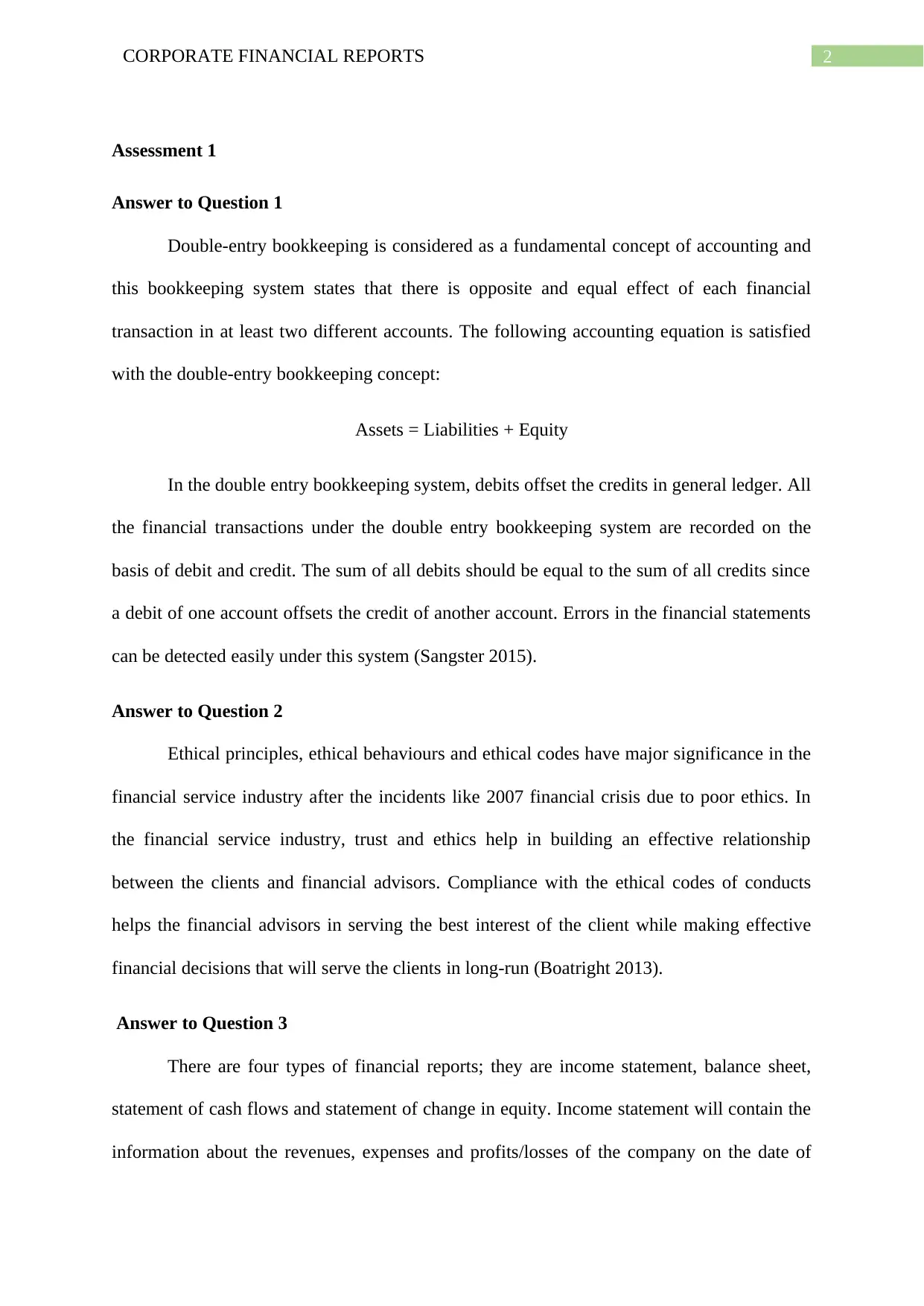
2CORPORATE FINANCIAL REPORTS
Assessment 1
Answer to Question 1
Double-entry bookkeeping is considered as a fundamental concept of accounting and
this bookkeeping system states that there is opposite and equal effect of each financial
transaction in at least two different accounts. The following accounting equation is satisfied
with the double-entry bookkeeping concept:
Assets = Liabilities + Equity
In the double entry bookkeeping system, debits offset the credits in general ledger. All
the financial transactions under the double entry bookkeeping system are recorded on the
basis of debit and credit. The sum of all debits should be equal to the sum of all credits since
a debit of one account offsets the credit of another account. Errors in the financial statements
can be detected easily under this system (Sangster 2015).
Answer to Question 2
Ethical principles, ethical behaviours and ethical codes have major significance in the
financial service industry after the incidents like 2007 financial crisis due to poor ethics. In
the financial service industry, trust and ethics help in building an effective relationship
between the clients and financial advisors. Compliance with the ethical codes of conducts
helps the financial advisors in serving the best interest of the client while making effective
financial decisions that will serve the clients in long-run (Boatright 2013).
Answer to Question 3
There are four types of financial reports; they are income statement, balance sheet,
statement of cash flows and statement of change in equity. Income statement will contain the
information about the revenues, expenses and profits/losses of the company on the date of
Assessment 1
Answer to Question 1
Double-entry bookkeeping is considered as a fundamental concept of accounting and
this bookkeeping system states that there is opposite and equal effect of each financial
transaction in at least two different accounts. The following accounting equation is satisfied
with the double-entry bookkeeping concept:
Assets = Liabilities + Equity
In the double entry bookkeeping system, debits offset the credits in general ledger. All
the financial transactions under the double entry bookkeeping system are recorded on the
basis of debit and credit. The sum of all debits should be equal to the sum of all credits since
a debit of one account offsets the credit of another account. Errors in the financial statements
can be detected easily under this system (Sangster 2015).
Answer to Question 2
Ethical principles, ethical behaviours and ethical codes have major significance in the
financial service industry after the incidents like 2007 financial crisis due to poor ethics. In
the financial service industry, trust and ethics help in building an effective relationship
between the clients and financial advisors. Compliance with the ethical codes of conducts
helps the financial advisors in serving the best interest of the client while making effective
financial decisions that will serve the clients in long-run (Boatright 2013).
Answer to Question 3
There are four types of financial reports; they are income statement, balance sheet,
statement of cash flows and statement of change in equity. Income statement will contain the
information about the revenues, expenses and profits/losses of the company on the date of
⊘ This is a preview!⊘
Do you want full access?
Subscribe today to unlock all pages.

Trusted by 1+ million students worldwide
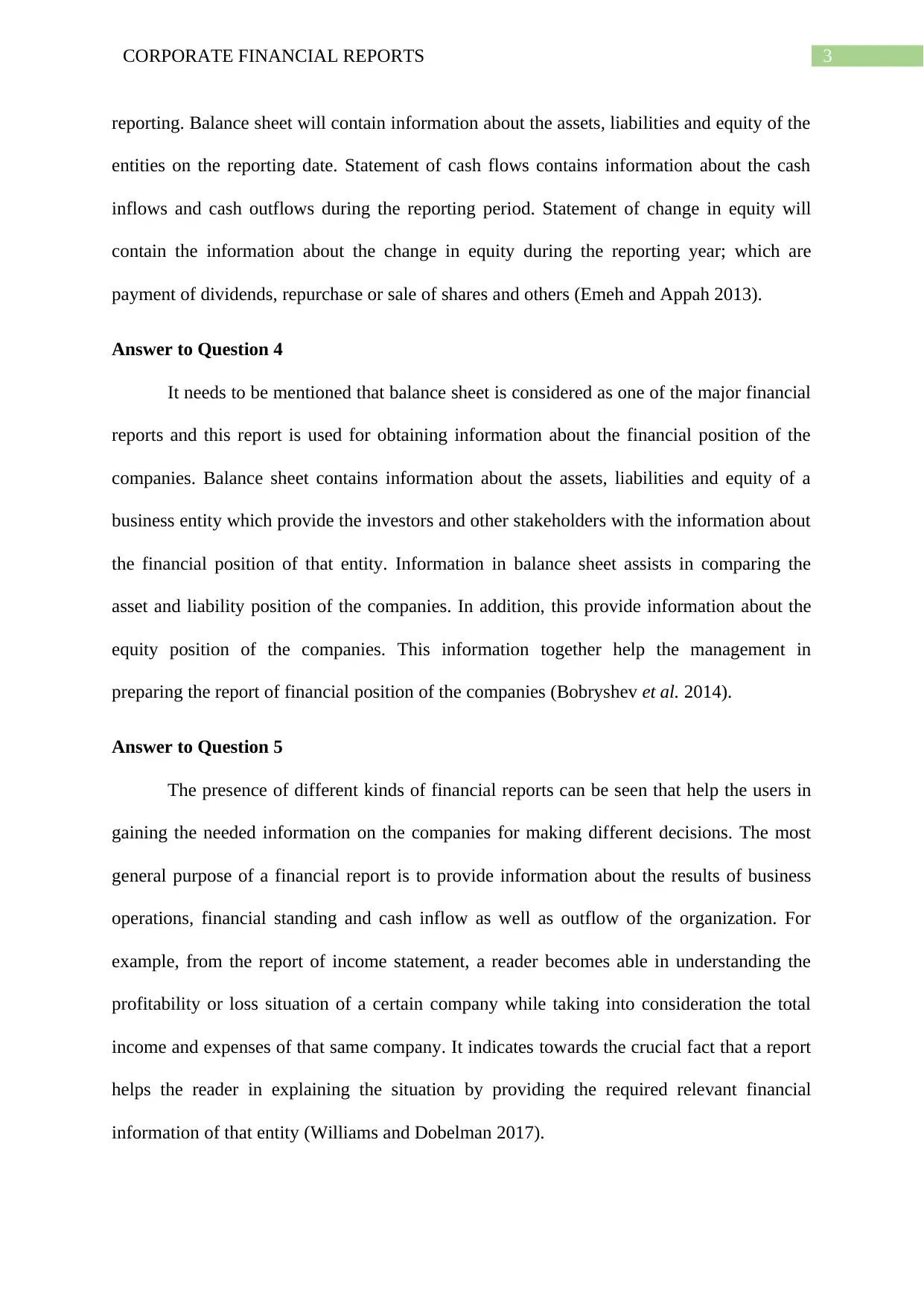
3CORPORATE FINANCIAL REPORTS
reporting. Balance sheet will contain information about the assets, liabilities and equity of the
entities on the reporting date. Statement of cash flows contains information about the cash
inflows and cash outflows during the reporting period. Statement of change in equity will
contain the information about the change in equity during the reporting year; which are
payment of dividends, repurchase or sale of shares and others (Emeh and Appah 2013).
Answer to Question 4
It needs to be mentioned that balance sheet is considered as one of the major financial
reports and this report is used for obtaining information about the financial position of the
companies. Balance sheet contains information about the assets, liabilities and equity of a
business entity which provide the investors and other stakeholders with the information about
the financial position of that entity. Information in balance sheet assists in comparing the
asset and liability position of the companies. In addition, this provide information about the
equity position of the companies. This information together help the management in
preparing the report of financial position of the companies (Bobryshev et al. 2014).
Answer to Question 5
The presence of different kinds of financial reports can be seen that help the users in
gaining the needed information on the companies for making different decisions. The most
general purpose of a financial report is to provide information about the results of business
operations, financial standing and cash inflow as well as outflow of the organization. For
example, from the report of income statement, a reader becomes able in understanding the
profitability or loss situation of a certain company while taking into consideration the total
income and expenses of that same company. It indicates towards the crucial fact that a report
helps the reader in explaining the situation by providing the required relevant financial
information of that entity (Williams and Dobelman 2017).
reporting. Balance sheet will contain information about the assets, liabilities and equity of the
entities on the reporting date. Statement of cash flows contains information about the cash
inflows and cash outflows during the reporting period. Statement of change in equity will
contain the information about the change in equity during the reporting year; which are
payment of dividends, repurchase or sale of shares and others (Emeh and Appah 2013).
Answer to Question 4
It needs to be mentioned that balance sheet is considered as one of the major financial
reports and this report is used for obtaining information about the financial position of the
companies. Balance sheet contains information about the assets, liabilities and equity of a
business entity which provide the investors and other stakeholders with the information about
the financial position of that entity. Information in balance sheet assists in comparing the
asset and liability position of the companies. In addition, this provide information about the
equity position of the companies. This information together help the management in
preparing the report of financial position of the companies (Bobryshev et al. 2014).
Answer to Question 5
The presence of different kinds of financial reports can be seen that help the users in
gaining the needed information on the companies for making different decisions. The most
general purpose of a financial report is to provide information about the results of business
operations, financial standing and cash inflow as well as outflow of the organization. For
example, from the report of income statement, a reader becomes able in understanding the
profitability or loss situation of a certain company while taking into consideration the total
income and expenses of that same company. It indicates towards the crucial fact that a report
helps the reader in explaining the situation by providing the required relevant financial
information of that entity (Williams and Dobelman 2017).
Paraphrase This Document
Need a fresh take? Get an instant paraphrase of this document with our AI Paraphraser
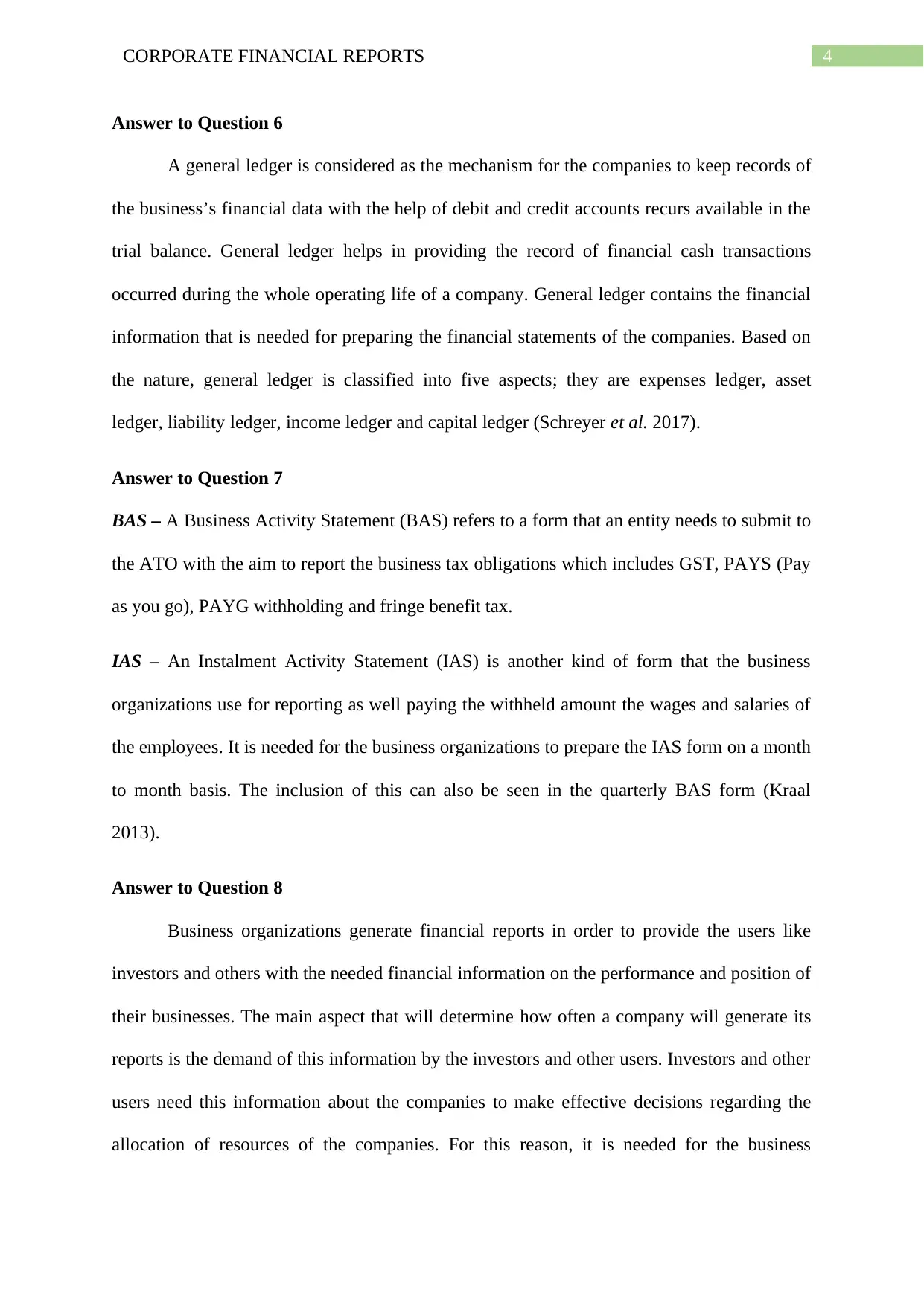
4CORPORATE FINANCIAL REPORTS
Answer to Question 6
A general ledger is considered as the mechanism for the companies to keep records of
the business’s financial data with the help of debit and credit accounts recurs available in the
trial balance. General ledger helps in providing the record of financial cash transactions
occurred during the whole operating life of a company. General ledger contains the financial
information that is needed for preparing the financial statements of the companies. Based on
the nature, general ledger is classified into five aspects; they are expenses ledger, asset
ledger, liability ledger, income ledger and capital ledger (Schreyer et al. 2017).
Answer to Question 7
BAS – A Business Activity Statement (BAS) refers to a form that an entity needs to submit to
the ATO with the aim to report the business tax obligations which includes GST, PAYS (Pay
as you go), PAYG withholding and fringe benefit tax.
IAS – An Instalment Activity Statement (IAS) is another kind of form that the business
organizations use for reporting as well paying the withheld amount the wages and salaries of
the employees. It is needed for the business organizations to prepare the IAS form on a month
to month basis. The inclusion of this can also be seen in the quarterly BAS form (Kraal
2013).
Answer to Question 8
Business organizations generate financial reports in order to provide the users like
investors and others with the needed financial information on the performance and position of
their businesses. The main aspect that will determine how often a company will generate its
reports is the demand of this information by the investors and other users. Investors and other
users need this information about the companies to make effective decisions regarding the
allocation of resources of the companies. For this reason, it is needed for the business
Answer to Question 6
A general ledger is considered as the mechanism for the companies to keep records of
the business’s financial data with the help of debit and credit accounts recurs available in the
trial balance. General ledger helps in providing the record of financial cash transactions
occurred during the whole operating life of a company. General ledger contains the financial
information that is needed for preparing the financial statements of the companies. Based on
the nature, general ledger is classified into five aspects; they are expenses ledger, asset
ledger, liability ledger, income ledger and capital ledger (Schreyer et al. 2017).
Answer to Question 7
BAS – A Business Activity Statement (BAS) refers to a form that an entity needs to submit to
the ATO with the aim to report the business tax obligations which includes GST, PAYS (Pay
as you go), PAYG withholding and fringe benefit tax.
IAS – An Instalment Activity Statement (IAS) is another kind of form that the business
organizations use for reporting as well paying the withheld amount the wages and salaries of
the employees. It is needed for the business organizations to prepare the IAS form on a month
to month basis. The inclusion of this can also be seen in the quarterly BAS form (Kraal
2013).
Answer to Question 8
Business organizations generate financial reports in order to provide the users like
investors and others with the needed financial information on the performance and position of
their businesses. The main aspect that will determine how often a company will generate its
reports is the demand of this information by the investors and other users. Investors and other
users need this information about the companies to make effective decisions regarding the
allocation of resources of the companies. For this reason, it is needed for the business
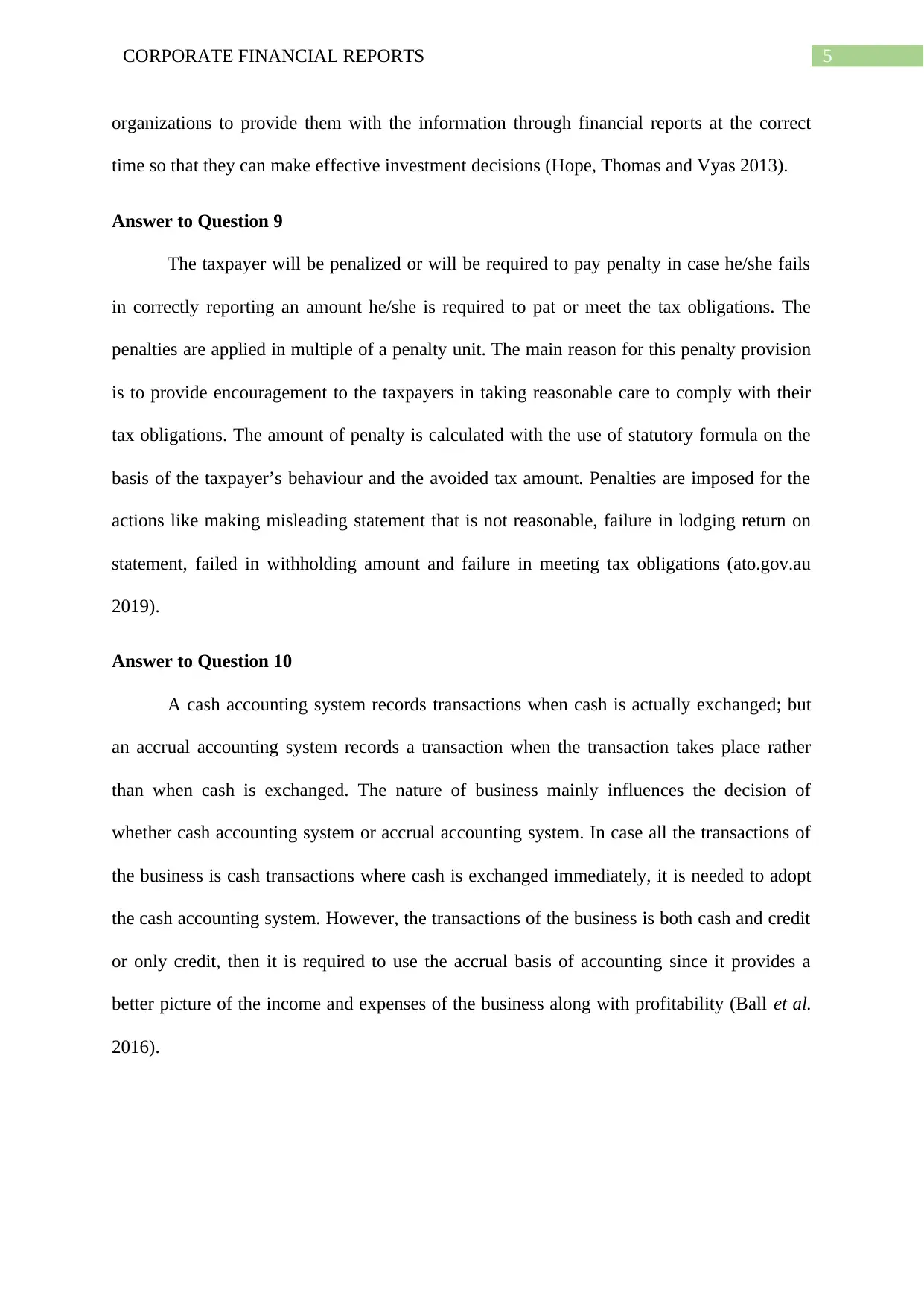
5CORPORATE FINANCIAL REPORTS
organizations to provide them with the information through financial reports at the correct
time so that they can make effective investment decisions (Hope, Thomas and Vyas 2013).
Answer to Question 9
The taxpayer will be penalized or will be required to pay penalty in case he/she fails
in correctly reporting an amount he/she is required to pat or meet the tax obligations. The
penalties are applied in multiple of a penalty unit. The main reason for this penalty provision
is to provide encouragement to the taxpayers in taking reasonable care to comply with their
tax obligations. The amount of penalty is calculated with the use of statutory formula on the
basis of the taxpayer’s behaviour and the avoided tax amount. Penalties are imposed for the
actions like making misleading statement that is not reasonable, failure in lodging return on
statement, failed in withholding amount and failure in meeting tax obligations (ato.gov.au
2019).
Answer to Question 10
A cash accounting system records transactions when cash is actually exchanged; but
an accrual accounting system records a transaction when the transaction takes place rather
than when cash is exchanged. The nature of business mainly influences the decision of
whether cash accounting system or accrual accounting system. In case all the transactions of
the business is cash transactions where cash is exchanged immediately, it is needed to adopt
the cash accounting system. However, the transactions of the business is both cash and credit
or only credit, then it is required to use the accrual basis of accounting since it provides a
better picture of the income and expenses of the business along with profitability (Ball et al.
2016).
organizations to provide them with the information through financial reports at the correct
time so that they can make effective investment decisions (Hope, Thomas and Vyas 2013).
Answer to Question 9
The taxpayer will be penalized or will be required to pay penalty in case he/she fails
in correctly reporting an amount he/she is required to pat or meet the tax obligations. The
penalties are applied in multiple of a penalty unit. The main reason for this penalty provision
is to provide encouragement to the taxpayers in taking reasonable care to comply with their
tax obligations. The amount of penalty is calculated with the use of statutory formula on the
basis of the taxpayer’s behaviour and the avoided tax amount. Penalties are imposed for the
actions like making misleading statement that is not reasonable, failure in lodging return on
statement, failed in withholding amount and failure in meeting tax obligations (ato.gov.au
2019).
Answer to Question 10
A cash accounting system records transactions when cash is actually exchanged; but
an accrual accounting system records a transaction when the transaction takes place rather
than when cash is exchanged. The nature of business mainly influences the decision of
whether cash accounting system or accrual accounting system. In case all the transactions of
the business is cash transactions where cash is exchanged immediately, it is needed to adopt
the cash accounting system. However, the transactions of the business is both cash and credit
or only credit, then it is required to use the accrual basis of accounting since it provides a
better picture of the income and expenses of the business along with profitability (Ball et al.
2016).
⊘ This is a preview!⊘
Do you want full access?
Subscribe today to unlock all pages.

Trusted by 1+ million students worldwide
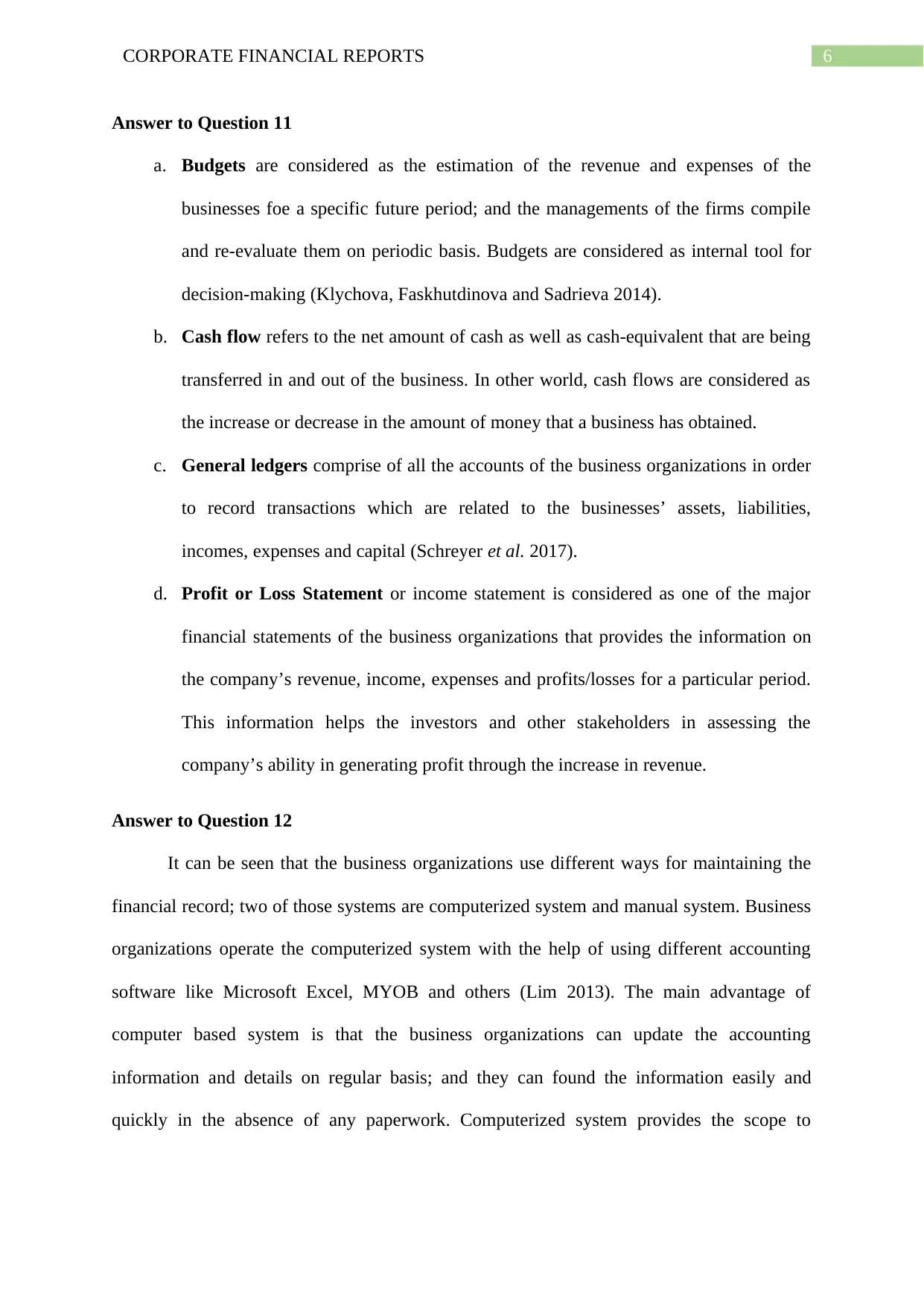
6CORPORATE FINANCIAL REPORTS
Answer to Question 11
a. Budgets are considered as the estimation of the revenue and expenses of the
businesses foe a specific future period; and the managements of the firms compile
and re-evaluate them on periodic basis. Budgets are considered as internal tool for
decision-making (Klychova, Faskhutdinova and Sadrieva 2014).
b. Cash flow refers to the net amount of cash as well as cash-equivalent that are being
transferred in and out of the business. In other world, cash flows are considered as
the increase or decrease in the amount of money that a business has obtained.
c. General ledgers comprise of all the accounts of the business organizations in order
to record transactions which are related to the businesses’ assets, liabilities,
incomes, expenses and capital (Schreyer et al. 2017).
d. Profit or Loss Statement or income statement is considered as one of the major
financial statements of the business organizations that provides the information on
the company’s revenue, income, expenses and profits/losses for a particular period.
This information helps the investors and other stakeholders in assessing the
company’s ability in generating profit through the increase in revenue.
Answer to Question 12
It can be seen that the business organizations use different ways for maintaining the
financial record; two of those systems are computerized system and manual system. Business
organizations operate the computerized system with the help of using different accounting
software like Microsoft Excel, MYOB and others (Lim 2013). The main advantage of
computer based system is that the business organizations can update the accounting
information and details on regular basis; and they can found the information easily and
quickly in the absence of any paperwork. Computerized system provides the scope to
Answer to Question 11
a. Budgets are considered as the estimation of the revenue and expenses of the
businesses foe a specific future period; and the managements of the firms compile
and re-evaluate them on periodic basis. Budgets are considered as internal tool for
decision-making (Klychova, Faskhutdinova and Sadrieva 2014).
b. Cash flow refers to the net amount of cash as well as cash-equivalent that are being
transferred in and out of the business. In other world, cash flows are considered as
the increase or decrease in the amount of money that a business has obtained.
c. General ledgers comprise of all the accounts of the business organizations in order
to record transactions which are related to the businesses’ assets, liabilities,
incomes, expenses and capital (Schreyer et al. 2017).
d. Profit or Loss Statement or income statement is considered as one of the major
financial statements of the business organizations that provides the information on
the company’s revenue, income, expenses and profits/losses for a particular period.
This information helps the investors and other stakeholders in assessing the
company’s ability in generating profit through the increase in revenue.
Answer to Question 12
It can be seen that the business organizations use different ways for maintaining the
financial record; two of those systems are computerized system and manual system. Business
organizations operate the computerized system with the help of using different accounting
software like Microsoft Excel, MYOB and others (Lim 2013). The main advantage of
computer based system is that the business organizations can update the accounting
information and details on regular basis; and they can found the information easily and
quickly in the absence of any paperwork. Computerized system provides the scope to
Paraphrase This Document
Need a fresh take? Get an instant paraphrase of this document with our AI Paraphraser
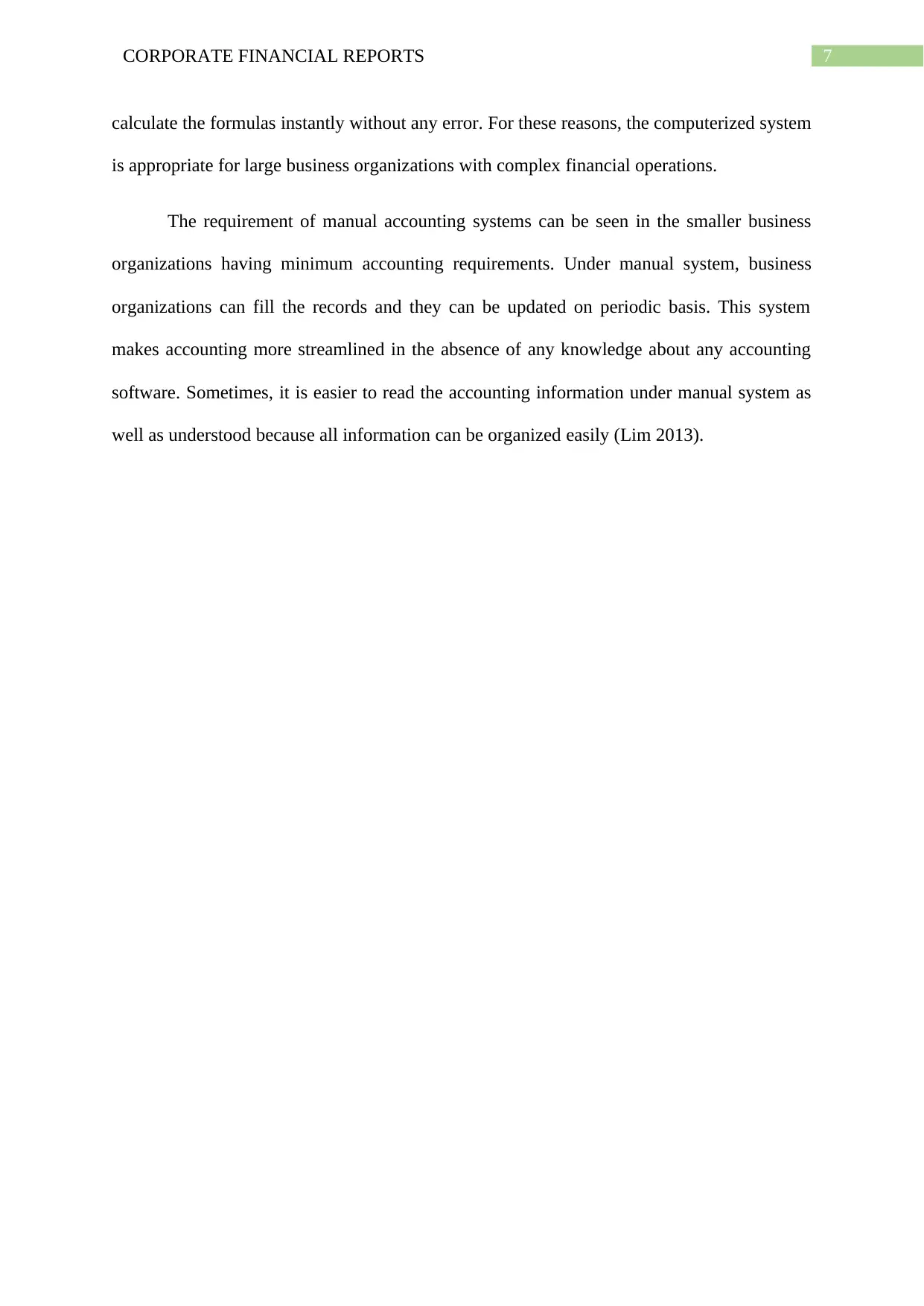
7CORPORATE FINANCIAL REPORTS
calculate the formulas instantly without any error. For these reasons, the computerized system
is appropriate for large business organizations with complex financial operations.
The requirement of manual accounting systems can be seen in the smaller business
organizations having minimum accounting requirements. Under manual system, business
organizations can fill the records and they can be updated on periodic basis. This system
makes accounting more streamlined in the absence of any knowledge about any accounting
software. Sometimes, it is easier to read the accounting information under manual system as
well as understood because all information can be organized easily (Lim 2013).
calculate the formulas instantly without any error. For these reasons, the computerized system
is appropriate for large business organizations with complex financial operations.
The requirement of manual accounting systems can be seen in the smaller business
organizations having minimum accounting requirements. Under manual system, business
organizations can fill the records and they can be updated on periodic basis. This system
makes accounting more streamlined in the absence of any knowledge about any accounting
software. Sometimes, it is easier to read the accounting information under manual system as
well as understood because all information can be organized easily (Lim 2013).
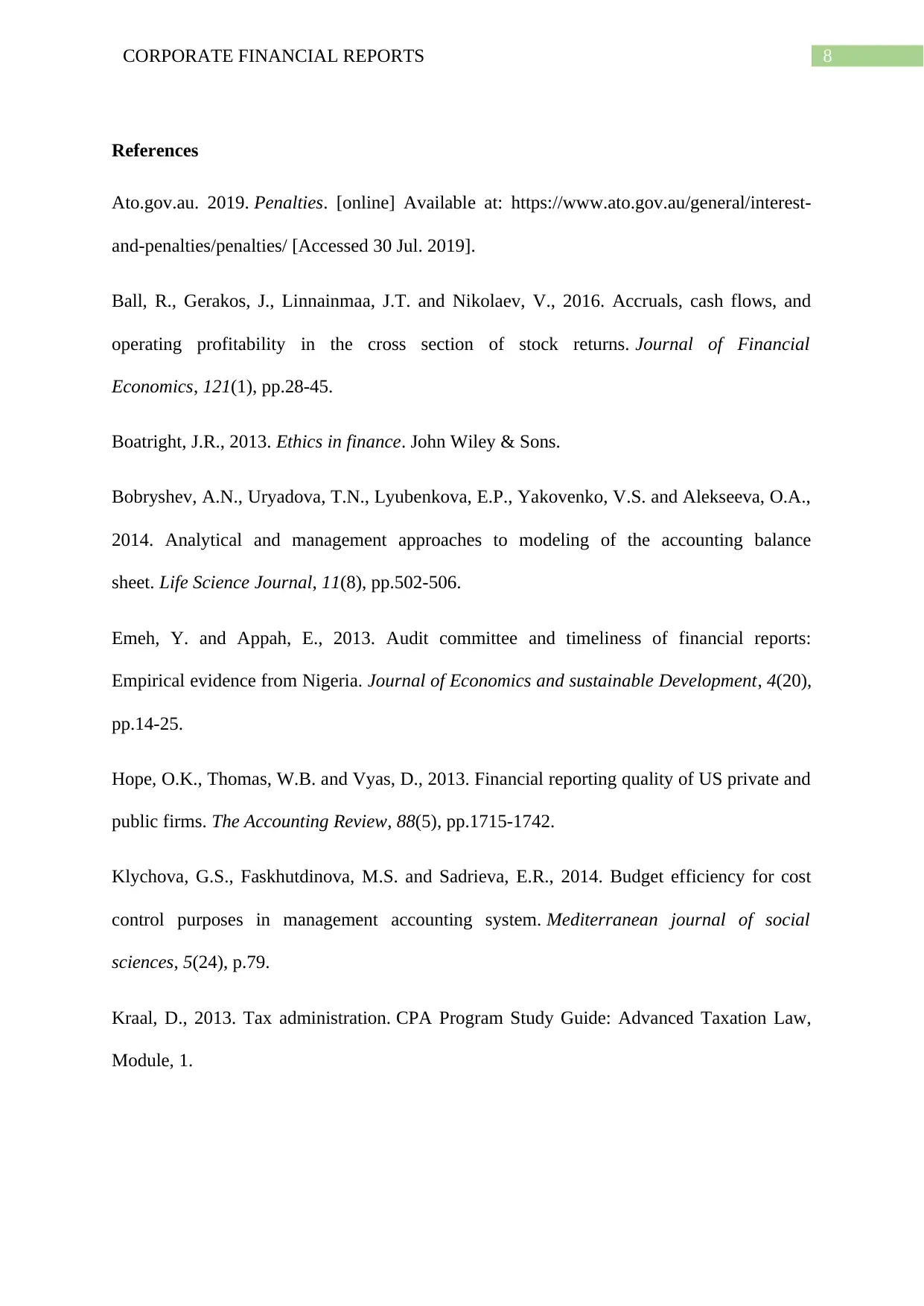
8CORPORATE FINANCIAL REPORTS
References
Ato.gov.au. 2019. Penalties. [online] Available at: https://www.ato.gov.au/general/interest-
and-penalties/penalties/ [Accessed 30 Jul. 2019].
Ball, R., Gerakos, J., Linnainmaa, J.T. and Nikolaev, V., 2016. Accruals, cash flows, and
operating profitability in the cross section of stock returns. Journal of Financial
Economics, 121(1), pp.28-45.
Boatright, J.R., 2013. Ethics in finance. John Wiley & Sons.
Bobryshev, A.N., Uryadova, T.N., Lyubenkova, E.P., Yakovenko, V.S. and Alekseeva, O.A.,
2014. Analytical and management approaches to modeling of the accounting balance
sheet. Life Science Journal, 11(8), pp.502-506.
Emeh, Y. and Appah, E., 2013. Audit committee and timeliness of financial reports:
Empirical evidence from Nigeria. Journal of Economics and sustainable Development, 4(20),
pp.14-25.
Hope, O.K., Thomas, W.B. and Vyas, D., 2013. Financial reporting quality of US private and
public firms. The Accounting Review, 88(5), pp.1715-1742.
Klychova, G.S., Faskhutdinova, М.S. and Sadrieva, E.R., 2014. Budget efficiency for cost
control purposes in management accounting system. Mediterranean journal of social
sciences, 5(24), p.79.
Kraal, D., 2013. Tax administration. CPA Program Study Guide: Advanced Taxation Law,
Module, 1.
References
Ato.gov.au. 2019. Penalties. [online] Available at: https://www.ato.gov.au/general/interest-
and-penalties/penalties/ [Accessed 30 Jul. 2019].
Ball, R., Gerakos, J., Linnainmaa, J.T. and Nikolaev, V., 2016. Accruals, cash flows, and
operating profitability in the cross section of stock returns. Journal of Financial
Economics, 121(1), pp.28-45.
Boatright, J.R., 2013. Ethics in finance. John Wiley & Sons.
Bobryshev, A.N., Uryadova, T.N., Lyubenkova, E.P., Yakovenko, V.S. and Alekseeva, O.A.,
2014. Analytical and management approaches to modeling of the accounting balance
sheet. Life Science Journal, 11(8), pp.502-506.
Emeh, Y. and Appah, E., 2013. Audit committee and timeliness of financial reports:
Empirical evidence from Nigeria. Journal of Economics and sustainable Development, 4(20),
pp.14-25.
Hope, O.K., Thomas, W.B. and Vyas, D., 2013. Financial reporting quality of US private and
public firms. The Accounting Review, 88(5), pp.1715-1742.
Klychova, G.S., Faskhutdinova, М.S. and Sadrieva, E.R., 2014. Budget efficiency for cost
control purposes in management accounting system. Mediterranean journal of social
sciences, 5(24), p.79.
Kraal, D., 2013. Tax administration. CPA Program Study Guide: Advanced Taxation Law,
Module, 1.
⊘ This is a preview!⊘
Do you want full access?
Subscribe today to unlock all pages.

Trusted by 1+ million students worldwide
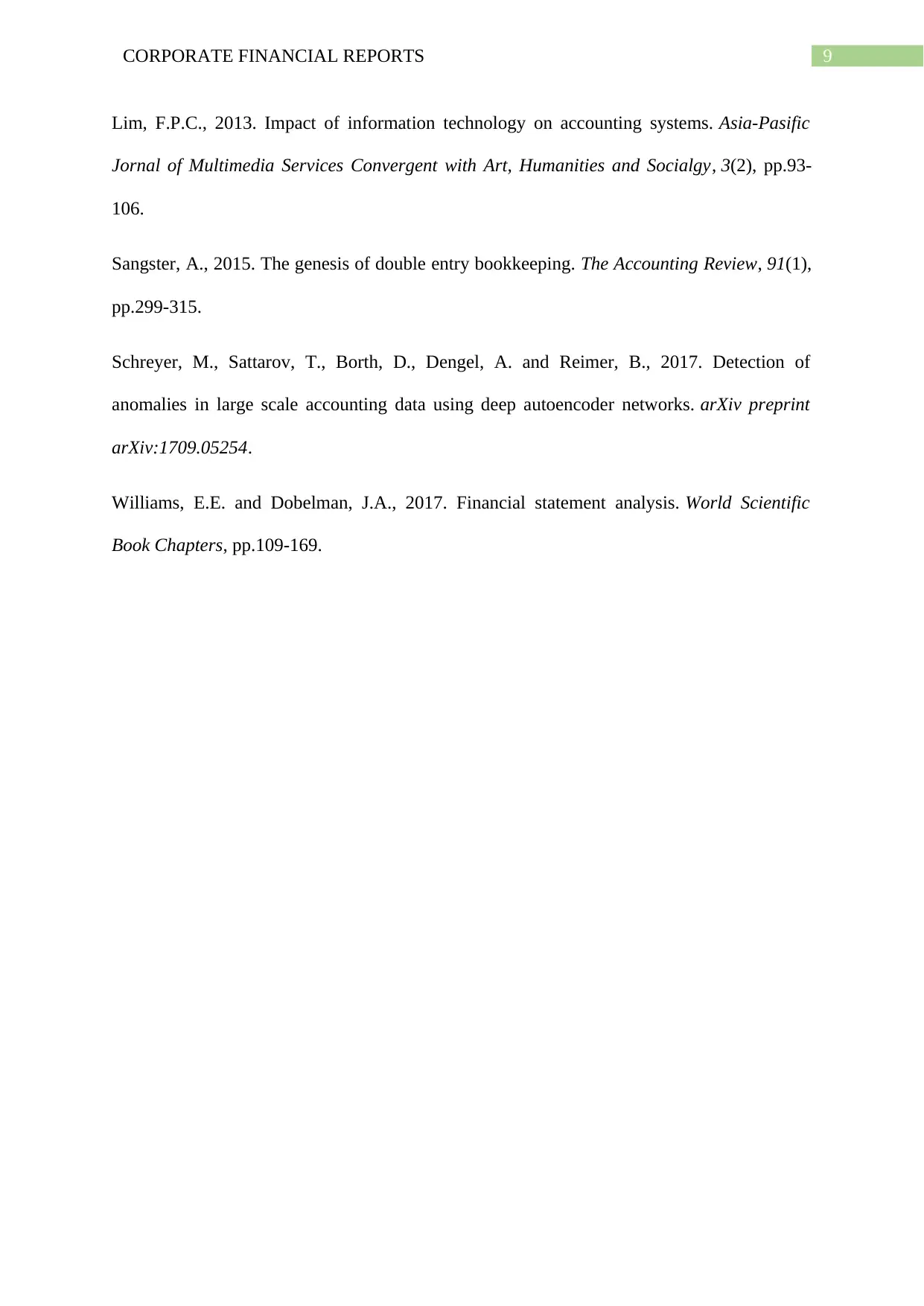
9CORPORATE FINANCIAL REPORTS
Lim, F.P.C., 2013. Impact of information technology on accounting systems. Asia-Pasific
Jornal of Multimedia Services Convergent with Art, Humanities and Socialgy, 3(2), pp.93-
106.
Sangster, A., 2015. The genesis of double entry bookkeeping. The Accounting Review, 91(1),
pp.299-315.
Schreyer, M., Sattarov, T., Borth, D., Dengel, A. and Reimer, B., 2017. Detection of
anomalies in large scale accounting data using deep autoencoder networks. arXiv preprint
arXiv:1709.05254.
Williams, E.E. and Dobelman, J.A., 2017. Financial statement analysis. World Scientific
Book Chapters, pp.109-169.
Lim, F.P.C., 2013. Impact of information technology on accounting systems. Asia-Pasific
Jornal of Multimedia Services Convergent with Art, Humanities and Socialgy, 3(2), pp.93-
106.
Sangster, A., 2015. The genesis of double entry bookkeeping. The Accounting Review, 91(1),
pp.299-315.
Schreyer, M., Sattarov, T., Borth, D., Dengel, A. and Reimer, B., 2017. Detection of
anomalies in large scale accounting data using deep autoencoder networks. arXiv preprint
arXiv:1709.05254.
Williams, E.E. and Dobelman, J.A., 2017. Financial statement analysis. World Scientific
Book Chapters, pp.109-169.
1 out of 10
Related Documents
Your All-in-One AI-Powered Toolkit for Academic Success.
+13062052269
info@desklib.com
Available 24*7 on WhatsApp / Email
![[object Object]](/_next/static/media/star-bottom.7253800d.svg)
Unlock your academic potential
Copyright © 2020–2025 A2Z Services. All Rights Reserved. Developed and managed by ZUCOL.





